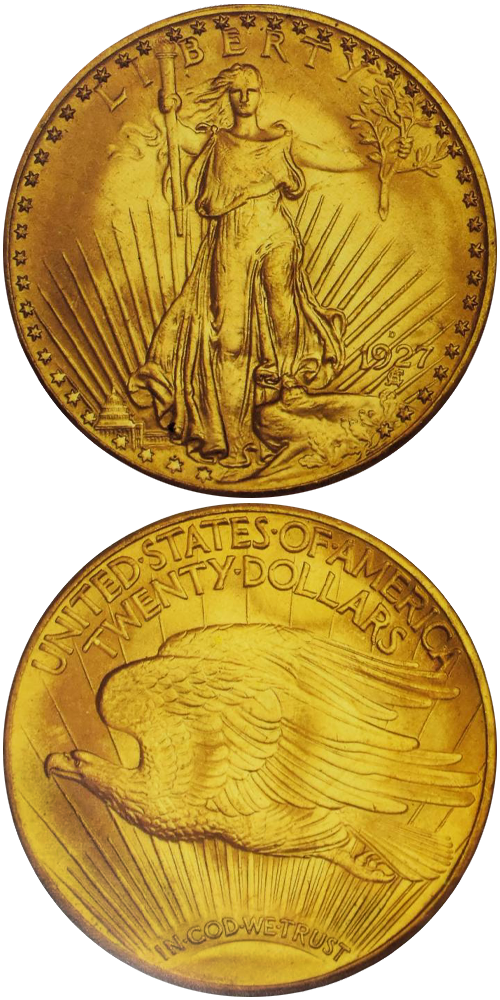1927-D Saint Gaudens Double Eagle
The 1927-D Saint Gaudens Double Eagle is today considered the premier U.S. gold rarity of the 20th century (aside from the 1933 $20, of which only one can be privately held). Despite its mintage of 180,000, a mere 12 or 13 pieces have been accounted for today, and rest were undoubtedly melted sometime around 1933 or 1934 following the gold recall.
David Akers commented on the 1927-D in both his 1975 and 1988 works as well as updated information in 2008, saying in part:
The 1927-D is by far the rarest collectible, regular-issue Saint-Gaudens double eagle. Furthermore, it is also the rarest 20th century United States gold coin of any denomination. (the 1933 Double Eagle is considered essentially uncollectible because the federal government has legalized only a single example for private ownership). Estimates on the number of 1927-D Double Eagles extant vary, but we feel that a range of 12-20 pieces is most appropriate.
This issue was noticeably absent from the hoards of Double Eagles that returned to the United States from South America and Europe during the 1950s, 1960s, 1970s, and 1980s. It is likely, therefore, that all but a few of the 180,000 pieces struck remained secluded in federal vaults and were eventually destroyed during the 1930s. Most survivors were probably obtained directly from the Mint or Treasury Department during or shortly after the year of issue - a theory that gains support from the fact that virtually all 1927-D Double Eagles grade MS63 or finer. In fact, the 1927-D is not the rarest collectible Saint-Gaudens Double Eagle in high grades. The 1920, 1920-S, 1921, 1925-D, 1925-S and 1926-D are all more difficult to locate beginning in MS65.
In the 1940's, when many great collections were sold (J.F. Bell, Flanagan, WGC, Atwater etc.), the 1927-D was considered to be rare but it was not held in the same high regard as the 1924-S and 1926-D which were considered to be the two rarest dates in the series, nor was it thought to be as rare as the 1926-S, 1927-S, or 1931-D. However, since the early 1950's additional specimens of all others have turned up but, to the best of my knowledge, no "new" 1927-D Double Eagles have been discovered during that time.
The mintage of the 1927-D is low by late date standards but a number of different sets of dies were used to strike the 180,000 coins. Most, but not all, existing specimens were struck from the same pair of dies with the following characteristics. Obverse: Thin hairline die crack from star to star at the top of the L in LIBERTY. Another thin die crack running from the base of the L to the torch. Reverse: Thin vertical die scratch through the eagle's beak. A 1927-D with these characteristics is undoubtedly genuine. However, a specimen without these characteristics is not necessarily a fake because it may have been struck from one of the other pairs of dies used.
The 1927-D is always well struck, except that the stars in the lower left quadrant are normally flat. The surfaces are always frosty, and the color and lustre are very good to excellent. All specimens that I have seen have similar color, a light medium orange and greenish gold. Not surprisingly, a nice 1927-D (and most of them are nice) looks very much like a nice 1923-D or 1924-D.”
Much of the shifting rarity rankings for U.S. gold coins is based on the discoveries in Europe which reached their zenith from the 1950s through the 1980s. During that period, many formerly “rare” coins turned up in European bank vaults and were repatriated back to the States. Such issues as the 1926-D, 1924-S, 1925-S, 1920-S, 1921 and several others, while still premium dates, have seen adjustments to their perceived rarity by numismatists over the past 75 years.
One date that has failed to turn up overseas, has been the 1927-D and that places it atop the list of collectible St. Gauden’s $20s. Of the roughly 13 pieces specifically traced, four reside in museums (all grade MS-65 or 66), seven have traded over the past 25 years or so (six grade MS-65 or higher), and two have not traded in at least fifty years, and their whereabouts are presently uncertain. The high average grade suggests that these pieces were probably not shipped overseas in bags at any time, and it is believed that the surviving specimens were likely obtained directly from the Denver Mint or the Treasury Dept.
While one cannot predict the future, or what may turn up eventually, it is probably safe to say that after nearly a century, the likelihood of a hoard of 1927-D’s turning up is quite slim, and unless legal proceedings change the status of the additional 1933’s presently being held by the government, the 1927-D will continue it’s reign as the King of 20th Century U.S. gold coins.
The example to the left was sold by Stack's Bowers Galleries in the 1991 Charlotte Collection Auction, where it realized $522,500.






